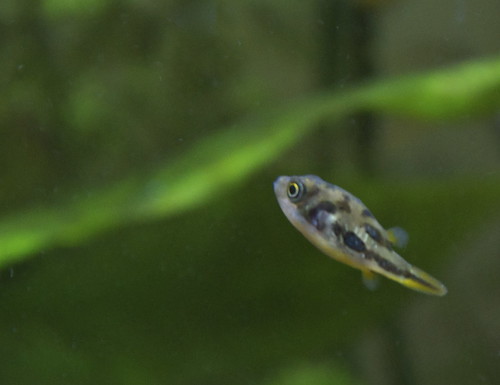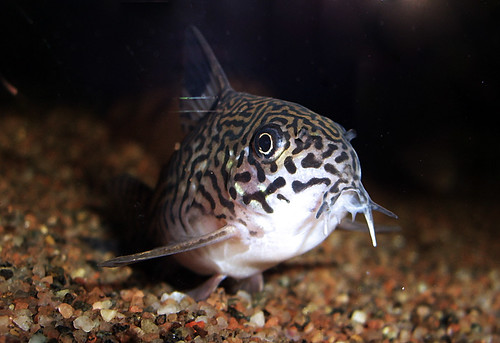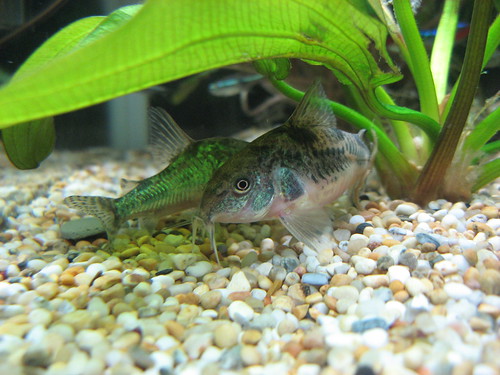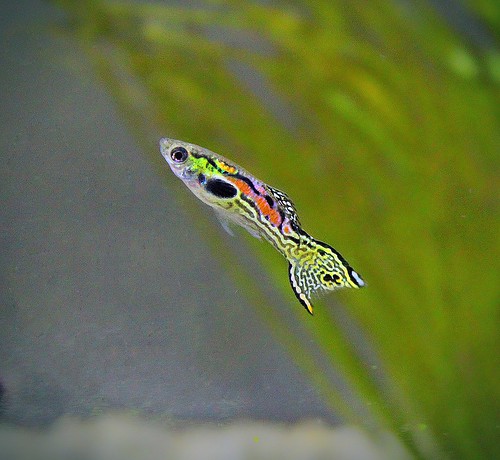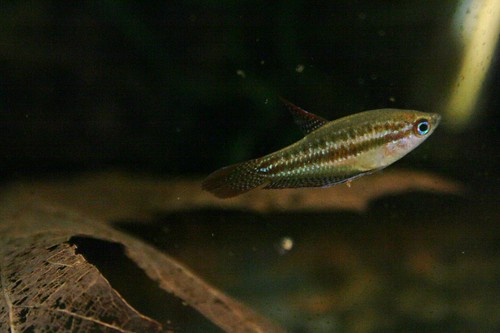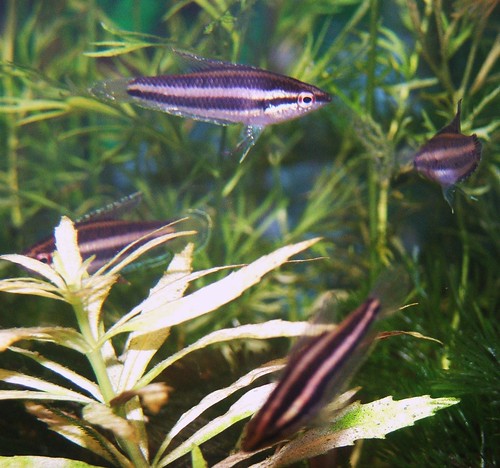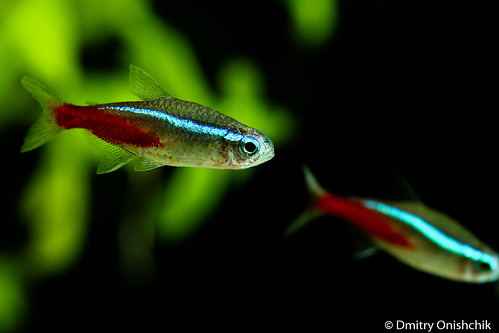In this article we have listed a few popular species of small fish to choose from for your small aquariums. These fish are easy to care for and won’t out grow your small fish tank size.
The species on this list don’t require a lot as long as you provide good fish food, a few live plants a filter, clean water and they should live for a very long time.
Finding the right fish for your freshwater nano tank can be quite the task. One wrong fish can throw off the ecosystem entirely.
A regular-sized Chinese Algae Eater, for example, would probably not be a good idea. As you can already imagine, fully grown, it would thrash about any nano-tank, wreaking havoc upon the other fish in this small environment.
As any experienced fishkeeper knows, just because a tank is smaller, doesn’t mean that it requires less attention. So, new fishkeeping enthusiasts are warned.
The good news is that once you do settle on the right fish, a well-populated nano tank can look great anywhere. It is not uncommon to see a beautiful nano tank on a desk at work or in your home, serving as both a pleasant sight and a source of natural inspiration throughout the day.
Further Reading: Best freshwater aquarium fish
So, without further ado, let’s take a look at some small fish that are great for nano tanks.
[toc]
5 Ideas For A Small Tank That Aren’t Fish
| Image | Title | Prime | Buy |
|---|---|---|---|
 Top
Top
Top
Top
Top
Top | SevenSeaSupply 6 Nerite Snails Combo Pack - 3 Tiger Nerite Snails, 3 Zebra Nerite Snails - Live Snails | Prime | Buy On Amazon |
 Top
Top | Java Moss Portion in 4 Oz Cup - Easy Live Fresh Water Aquarium Plants | Prime | Check Price On Amazon |
 Top
Top
Top
Top
Top
Top | Aquarium Creation 10 Red Cherry Shrimp Neocaridina davidi Live Freshwater Aquarium Shrimp | Prime | Buy On Amazon |
 Top
Top
Top
Top
Top
Top | White Mystery Snail - 1/2-2 inches - Algae Eater for Aquariums | Prime | Buy On Amazon |
 | Aquatic Arts 5 Large Amano Shrimp | Live Biofilm Eater / Remover / Glass Clearer for Freshwater Aquariums | Pet Caridina for Fish Tank / Aquarium | PrimeEligible | Check Price Now |
Our List Of Best Fish For A Small Tank
1. Ember Tetra
Care Level: Minimal
Size Of Fish: 2cm
Temperature: 73-84F
PH: 6.6
These small Brazilian freshwater fish make for great community fish. Their beauty is striking, being mostly red and orange with slightly translucent bodies.
A small fish tank, a minimum of 5-10 gallons, or a larger tank with a decent amount of live plants will be plenty of room for Ember Tetras; they will swim in a school and relaxing in the plants. Water conditions should be within 73-84F and a PH of 6.6.
What a lot of people don’t know about Ember Tetras, is that they prefer acidic water. They are also most comfortable in decently planted environments.
Aside from that, this species is fairly easy to maintain.
They prefer to be in the company of a group. In terms of diet feed them a a mix of flakes and dried goods. Some live foods can also be given to Ember Tetras, such as brine shrimp.
2. Pea Pufferfish
Care Level: Medium
Size Of Fish: 1.4in
Temperature: 77-79F
PH: 7-7.8
The Pea Pufferfish, also known as Pygmy Pufferfish, is a small species of pufferfish native to Southwest India. In recent years, many pet stores and aquariums have seen the addition of these fish. Because of how small they are, they fit into nano fish tank environments smaller than a 5 gallon.
Unlike Marine Pufferfish, Pea Pufferfish live exclusively in freshwater. Water conditions should be within 73-84F and a PH of 7-7.8.
Pea Pufferfish may be small but can show aggression at times, and this is something to keep in mind. They are also quite carnivorous, and will even prey upon live snails small enough to eat. Although they will eat some plant-based flakes for food it’s better to feed them a meatier diet that includes live food like insects and worms.
3. Sixray Corydoras
Care Level: Medium
Size Of Fish: 1.1in
Temperature: 72-77F
PH: 6-7.2
Sixray Cories is a freshwater fish that will rarely exceed an inch in size, making them a small and an ideal pet for a minimum 10 gallon tank size or larger. Their origin is South America, mainly Brazil. Water parameters should be within 72-77F and a PH of 6-7.2.
Technically, there are hundreds of cory species, many of which are unnamed. They are natural bottom feeders, eating both meat and plant-based food diet.
Sixray Cories need an aquatic environment that mimics a tropical setting. Like other fish on this list a fish tank with live plants is ideal to conceal their fry. They are another great peaceful chocie for beginner aquariums.
4. Scarlet Badis
Care Level: Medium
Size Of Fish: 2cm
Temperature: 75-79F
PH: 6.5-7.6
In terms of size and looks, Scarlet Badis are tiny and as close to the perfect pet for nano aquariums a minimum of 5-10 gallons. Though small, these species of fish can sometimes be aggressive, but mostly toward their fellow males.
Females have a tendency of being about 0.7 cm smaller than males on average. Males have a unique ventral fin, making them easy to identify.
The main thing to keep in mind when dealing with Scarlet Badis is that they are naturally predatorial.
Tanks containing a variety of objects like live plants and decorations are great for preventing tensions from escalating. Reason being is that these objects will cut off any clear line of sight, that may be a pathway toward aggression. In terms of food & diet, they need a mix of flakes and dried goods.
5. Hara Jerdoni
Care Level: Difficult
Size Of Fish: 1.5in
Temperature: 64-75F
PH range: 5.6-7.6
Hara Jerdoni is a freshwater fish were originally found in India. The Hara Jerdoni is one of the tiniest and small species of catfish, perfect for nano tanks.
These whiskered, bottom-dwelling fish are hardy, cute, and for the most part, inactive. They are content in small tanks and are not desperate for additional room to roam.
They tend to remain in the same location for the majority of the day, making them a great companion to other fish. However, their solitary nature doesn’t mean that they don’t require care. Tanks with above-average oxygen levels are ideal for these fish and should keep them thriving.
Forming the right habitat is the hardest part when looking after Hara Jerdoni fish as a pet. These smaller catfish need tanks with some form of cover, under which they can lounge for hours.
Basically, Hara Jerdoni tanks should be supplied with hiding places galore:
Although they can be alone, the company of a group is preferred. They are nocturnal and come feeding time, they will eat a variety of live, frozen, and dried food including shrimp and worms.
6. Pygmy Corydoras
Care Level: Minimal
Size Of Fish: 1.3in
Temperature: 72-79F
PH range: 6.5-7
Known for getting along well with Ember Tetras, Pygmy Cories are a hardy and active tiny fish. They can be quite social and warm toward other small nano tank friendly fish. They also live well among various shrimp species and water snails. Pygmy Corydoras are a mid-dwelling fish, preferring hiding in plants and swim around the tank in a school
Their colors, although not overly loud, suit them well. They are primarily silver-bodied, with a confident, unbroken black streak running from their mouth to their caudal fin. These calmer color patterns can easily balance out a tank.
Interestingly, Pygmy Corydoras fry can be distinguished from adults by identifying whether or not their black streaks are horizontal or vertical. Adults have horizontal black stripes, while the young will display vertical stripes.
Pygmy Corydoras are known for being relatively easy to care for. Females produce a large number of eggs, usually around 100. As far as diet, anything that sinks is fair game for Pygmy Corydoras. A variety of flakes, and even sinking wafers make good food for meals.
It is always best to add other small non-aggressive fish with the peaceful Pygmy Corydoras.
7. Salt And Pepper Catfish
Care Level: Minimal
Size Of Fish: 1.3in
Temperature: 75-78F
PH range: 5.5-7.5
Salt and Pepper Catfish are a South American species that can reach 1.5 inches in length. Being native to tropical environments, they are commonly seen in wetlands. The shallow waterways that they prefer, are often dangerous to their populations, as they are likely to dry.
Salt and Pepper Catfish are a hardy fish known for taking leisurely swims to the surface for gulps of air. Although this is normal for this species, if you see other fish in the aquarium doing so, it could be a sign of low oxygen levels.
Salt and Pepper Catfish thrive in a small school and need different types of flakes and pellets. Brine shrimp is considered a favorite. Their aquarium environment should be somewhat dense with plants and leaves, modeled after the tropical conditions they’re used to. They are a great choice for any beginner fish keeper and a peaceful option.
Aquarium Tip: aquarium maintenance is an ongoing battle to keep your aquarium happy and healthy here are just a few tips to help make your regular aquarium maintenance a breeze.
- Acclimate your fish.
- Float your fish.
- Room to swim.
- Quality water.
- Maintain proper pH levels.
- Replace aquarium water through water changes.
- Maintain adequate water temperature.
- Clean the sides of the tank.
For more detailed aquarium tips refer to our guide on which shows you how to clean an aquarium with some great tips, steps, and videos to help you get the clean and healthy aquarium you’ve always wanted.
8. Endlers Guppies
Care Level: Minimal
Size Of Fish: 1.8in
Temperature: 75-81F
PH range: 5.5-8
Endlers Guppies are ideal nano tank mates and will enjoy the room. If you decide on keeping Endlers you’ll see how these guppies are beautifully colored and peaceful. Although they are similar to regular guppies, they have been given different names for the sake of their own population, which sadly, is nearing extinction.
They’re very active and have even been known to keep algae levels low in some tanks.
Known for being fearless, these tiny Endler Guppies are willing to become familiar with just about anything. No areas of a nano tank are considered off-limits, in the mind of an Endler Guppy. Because of this, be sure that whatever filter you have like a slow flow option of the ability to install a pre-filter device to ensure they don’t get sucked into the filter.
Even during tank water changes, they are known for their curious investigations.
Like most guppies, they thrive in warm water, causing them to reach almost 2 inches in length. Tank covers are essential because jumping is one of their strong suits. They enjoy a variety of foods. Bloodworms are an Endler Guppy delicacy as well as an offering of a plant is also essential, especially as cover for their fry. They get along well with other fish, posing no threat, and will often engage in playful behavior.
Recommended tank size for Endlers would be a minimum of 5-10 gallons giving them plenty of space to swim and have their own community.
9. Sparkling Gouramis
Care Level: Medium
Max Size Of Fish: 1.6in
Temp: 77-83F
PH range: 6-7.5
Sparkling Gouramis are truly a fish of beauty. Their red, blue, and green sparkles allow them to stand out gorgeously in a nano tank size. A minimum of 10 gallons or larger will be plenty of space. They are shaped like miniature arrowheads and can grow to be almost 1.5 inches in length and very peaceful.
Aside from poor choices for companions, they are known for being a somewhat forgiving species in less suitable tank environments. This is partly due to their labyrinth organ, an organ that makes life easier for new aquarists. The labyrinth organ enables the Sparkling Gourami to engage in an alternative breathing technique, compared to most fish. This gives them the chance to breathe at surface levels, which they often take advantage of.
These fish like all kinds of foods, and a diet consisting of a mixture of frozen and live foods are ideal. Live foods such as bloodworms and brine shrimp are savored by this sparkling fish.
The only difficulty they present is the need to find the right tank mates. Bettas, especially males, can create issues for Sparkling Gouramis.
10. Licorice Gouramis
Care Level: Minimal
Max Size Of Fish: 1.3in
Temp: 74-82F
PH range: 5.6-7.2
The Licorice Gouramis are also some of the tiniest freshwater Gouramis, making them a dream come true for nano tank enthusiasts. They are beautiful to behold, displaying primarily black and silver color patterns.
In terms of setting, the Licorice Gourami does enjoy a fair amount of shade. This is where driftwood and a plant or two can come in handy. They are peaceful tank mates that enjoy both meaty and plant treats and can grow to be almost 1.5 inches in length.
Being a gentle fish, they prefer space and the company of other good-natured creatures. Proper nano tank filtration should be maintained, in order for to thrive. In contrast with most labyrinth fish, surface breathing is less common. Like other Gouramis, slightly acidic water goes a long way.
11. Green Neon Tetra
Level: Minimal
Max Size Of Fish: 1.3in
Water Temperature: 75-84F
PH range: 5-7.8
Not to be confused with the Neon, the Green Neon Tetras are great community tank freshwater fish that are the ideal size for nano tanks. Their reds are quieter than the Neon Tetra’s, but their blue-green regions are more defined. Although slightly less colorful than other popular tetras, they make up for it by being the perfect size for nano tanks.
Green Neon Tetras are beautiful in appearance, peaceful, and generally happy to other fish. They prefer a mixed diet consisting of a wide variety of live foods and pellets and can grow to be almost 1.5 inches in length.
Before purchasing a Green Neon, it’s good to read up on Neon Disease, which attacks Neon Tetras from the inside out. One of the main signs is white patches. Unfortunately, a cure for this parasitic affliction has yet to be discovered.
12. Neon Tetra
Level: Minimal
Max Size Of Fish: 1.3in
Water Temperature 70-77F
PH range: 6-6.5
Neon Tetras are some of the most beautiful community fish available to beginner aquarists. They prefer aquarium environments, that mimic what they have adapted to in nature.
They are mid dwelling fish enjoying the free space and possessing a faint-hearted temperament; Neon Tetras are peaceful will get along great with other fish their size. With diet, Neon Tetras will usually accept a wide variety of dried flake foods and can grow to be almost 1.5 inches in length.
At times their color may fade. This is usually a sign that they are under some form of stress. Unfortunately, aquarium settings usually cut their lifespans in half (from 10 to 5 years).
Final Thoughts
Nano tanks can make for absolutely beautiful aquariums. Most new aquarists choose a nano tank believing that because of their size, they are somehow easier to maintain. Unfortunately, these aquariums are often marketed as being the easy choice, for those new to the hobby. This is simply not realistic, and those who do come to realize this can quickly become overwhelmed.
With that said, they are less daunting in terms of appearance, which can be appealing. In the right hands, they make for truly lovely tanks. The key factor, of course, is information. With the right information and care keeping any nano tank environment has the opportunity to excel!
Did you enjoy this post? If you did please Pin It! so others can find it as well.

What fish can you keep in a nano tank?
To help you choose here is a recap of freshwater fish you can keep in your nano tank
- Ember Tetra
- Pea Pufferfish
- Sixray Corydoras
- Scarlet Badis
- Hara Jerdoni
- Pygmy Corydoras
- Salt And Pepper Catfish
- Endler Guppies
- Sparkling Gouramis
- Licorice Gouramis
- Green Neon Tetra (Schooling fish)
- Neon Tetra (Schooling fish)
Freshwater aquarium fish options not on this list
Celestial pearl: The celestial pearl danio, sometimes called the galaxy rasbora or Microrasbora is a very small easy to care for tropical fish that can also fit in a small tank size.
Peaceful Fish To Avoid
Another type of freshwater fish that some people might consider keeping in a nano tank are Danios, such as the zebra or pearl. Unfortunately, I don’t think Danios shouldn’t really be kept in anything much smaller than a 15 or 20 gallon aquarium. That said, Danios might be okay in a 10 gallon tank, but to be honest, they are a very active community tank fish that needs plenty of space to swim.
Male Betta
Try to avoid fish like the Betta, which are sometimes marketed as a popular fish for a nano tank. Bettas need about 5 gallons to be totally healthy. When it comes to betta fish tank shopping, bigger is better. Betta fish will do best in a tank that is at least 5 gallons. You can learn more about Betta Fish here.
What is considered a nano tank?
A Nano tank is a very small tank or aquarium used for fish, plants or other invertebrates. Typically the size of a Nano tank would be anything smaller than a 10 gallon tank.
thanks for reading if you have any questions feel free to email me.
Sources:
https://absolutelyfish.com/11-freshwater-nano-fish-for-your-aquarium/
http://www.tfhmagazine.com/details/articles/fantastic-freshwater-nano-fish.htm
https://www.youtube.com/watch?v=9O58wQ5CnA0
- Neon Tetra Disease & Managing Common Diseases in Neon Tetras - March 15, 2024
- How many neon tetras should you keep together? - March 15, 2024
- Complete Neon Tetra Care Guide for Aquarium Enthusiasts - March 15, 2024



